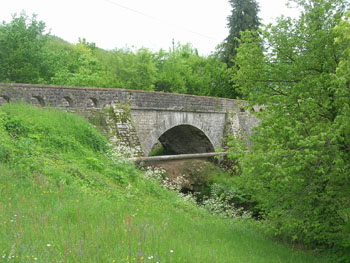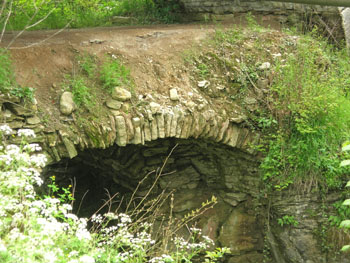| Card n. | Description | Locality | Linked sites |
| 64 | Bridge "Of Women" | Trichiana | 55 - 113 |
| file .pdf | Architecture Art History (ASA) |
Google maps |
 |
 |
- Description
- How to get there
- Interesting facts
- Bibliography
The ancient single-span bridge “delle femene” (of women) can be found near Campedei di Trichiana, close to the border between the provinces of Belluno and Treviso. It was built to cross the deep ravine of the Ardo, a torrent on the left side of the Piave with the same name as the one in Belluno, along which there were water-powered mills and workshops, as is recalled in the local place name Ai Mulini (at the mills), opposite Casteldardo. For centuries, the San Boldo Pass was an important communication route between the area left of the Piave and the Treviso plain, and was used by the raftsmen working on the Piave to return home. Recent studies indicate that the bridge, known as “delle femene” for reasons that remain unclear, was probably built around the 1360s by the nobleman from Belluno Caterino de Foro, who had become the owner of funds in Sant’ Antonio Tortal following a dispute with the Parish of S. Felice; he undertook to maintain efficiency, and was thus exonerated from paying taxes to Belluno town council and the Parish of S. Felice. As a result of marriage, the assets of the de Foro family ended up in the hands of Marte Scarpis who, in the 16th century regained the privilege of tax exemption that had been enjoyed by Caterino. However, this privilege obtained from the Podestà was removed by the Council of Ten of the Venetian Senate. There is clear documentary evidence that the bridge was used continually until at least the mid-17th century as is confirmed by the contracts for the maintenance of the road in the mid-19th century, and by documents from the early 20th century that mention the reconstruction and raising of the road surface.
The structure of the more recent bridge, built in 1915 over the original one, in non-squared stone, is only partially able to protect the older structure, now entirely covered in vegetation and earth.
From the SP1 you can reach the centre of Trichiana; from here, follow the road signs for the San Boldo Pass (SP635 S. Ubaldo Pass); about 1.5 km after Sant’Antonio di Tortal is Campedei, at the crossroads for Pianezze.
ACCESSIBLE: visible
MUNICIPALITY: Trichiana
PLACE: Campedei
GEOGRAPHICAL COORDINATES: X 1744836 – Y 5102626
PROVINCE: Belluno
FILE COMPILED BY: Guadagnin/Frapporti
Very much worth admiring is the ravine of the Ardo torrent, recognised by the Veneto Region as a geosite of regional importance. The name Brent dell’Art (113 NS) derives from the dialect word "Brentana", used to describe the overflow of a torrent or river due to heavy rain, and “dell'Art”, from “Ardo” in the local dialect. These ravines began to form at the end of the Wurmiana Ice Age (8-10 thousand years B.C.), as a result of the rainwater that carved out the cretaceous "scaglia" through both dissolution, caused by the carbonic acid, and abrasion, caused by the abrasive dust and particles carried along by the surface waters, which mainly went to work along the fractures in the marny limestone layers perpendicular to the slope. The ravine contains riparian vegetation formed by a complex environment, featuring fine flowering plants and historically consolidated plant species, with a rich variety of mosses and liverwort on the darkest walls and an abundance of ferns.
M. Frapporti, Pontem lapideum super aquam ardi ibi iuxta locum trotalis: un ponte medievale a Sant’Antonio di Tortal in “Archivio Storico Belluno Feltre Cadore”, LXXXI, no. 344, September-December 2010
E. Cason Angelini, Uso dei valichi alpini orientali dalla preistoria ai pellegrinaggi medievali, Udine, 2001
M. Frapporti, Tracce del Medioevo a Sant’Antonio Tortal, article taken from L’ombra

